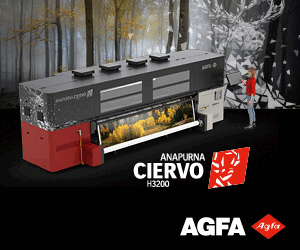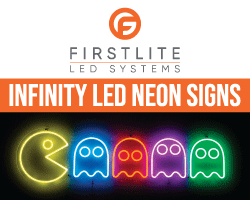In a new series of articles, Eye on Display looks into the value and importance sign-makers will gain by collaborating more effectively with trade partners.
This first article focuses on the relationship between sign-makers and electricians.
Life would be so much easier if we could focus on our own work and not be concerned about what anyone else is doing. However, this is seldom the reality, especially when it comes to sign projects that require electrical work.
If the sign-maker and the electrician work better together, they can ensure the project runs more smoothly and with fewer issues. This could help keep costs down for the customer and everyone else concerned. But it is rarely that easy.


The Challenges
Chris Smith, owner of #Electrical, explains some of the challenges he has faced working with sign-makers, “When I turn up at a sign project, I usually have to identify whether there’s a local power source, and if so, making sure it’s the correct size for the sign. Also, access can be challenging due to things like height or location. So, if a new power supply is needed, we need to work out how we get it to the sign, how it will be switched and whether it needs a timer.”
Chris Pankhurst of Pankhurst Electrical adds, “The most common challenge that electricians have is that many sign-makers leave the wiring for their signage too short. We need length to be able to work with the cable. Another common issue is that when sign-makers are providing materials for a project, ensuring that all the components are compatible with each other. Don’t send 12v LEDs with a 24V driver!”
He continues, “Well-presented electrical plans and technical specs provided by the sign-maker are like gold for us and ensure that we have the information we need to do a great job and get it right the first time. It is also good for the sign-maker to be there with us so we have onsite communication to work out any niggles and confirm locations of power or lighting for the signage.”
Chris Smith agrees and also refers to the technical considerations and requirements that sign-makers often overlook, “The most common issue is that we are rarely told in advance the size of the power supply and what is available on-site to power the sign. This means we might have to run a new cable to the sign, which takes time and adds cost. It would also be good to know if there is an external lighting driver, as this may need to be mounted in an external waterproof enclosure.”
Chris Pankhurst adds, “Access for cabling is normally forgotten about. Trying to get cabling in for signage on finished surfaces without a cable route is a nightmare. If the sign can come prewired and there is a clear way through any mounting, life is easy.”
Communication is everything
“Time is money,” says Chris Pankhurst. “So, anything the sign-maker can do to help speed us up will benefit their wallet and their customers. For example, if they leave the scaffold that they are working on, we don’t have to set up our own. Giving us a clear space to work in will help us to deliver the work faster and with fewer errors. Perhaps most importantly, tell us if there have been any changes as soon as possible. Fairly simple things like these will make us work that much faster.”
He adds, “An issue I see a lot of is when the electrician has quoted for providing power for the signage and the sign installers have only quoted for hanging the sign. This creates a gap in responsibility. Who is connecting the tails to the driver? Clear communication from the outset can save a lot of hassle, time and cost at the point of installation.”
“Having cabling barely make it into the cavity is a massive pain. If the cabling is long enough to reach the driver, this will go a long way to solving most problems. I always say ‘It’s better to look at it than for it’.”
Chris Smith also says communication is key. “In my opinion, good planning and communication is the most efficient and cost-effective way to get a job done. If there are special requirements for a job, or things we need to know, try to communicate this at the outset of the job. Miscommunication will invariably cost money that could have been saved.”
He continues with an example, “We had a situation where we needed to gain access to a roof to get behind the wall where the sign was mounted on to do our wiring work. The only way to get onto the roof was by using a boom lift, but no one had told us this. The sign-makers actually had a boom lift on the day of their installation. Had they communicated this to us, we would have planned to be on-site the same day, and it would have saved several hundred dollars.”
So what does Chris think sign-makers could do better when working with electricians? “Firstly, we need good team planning. For complicated jobs, a quick catch-up to go over the requirements means everyone is on the same page, and the job is more likely to run successfully. Secondly, good communication of the specs will help us plan the electrical side of the job.”
“Collaboration is key, and that extends to the customer. It’s always a good idea to visit the site of a job with the sign-makers to discuss requirements with the customers and build a plan together. This way, all parties have a good understanding of the job as a whole. With the evolution of digital tools, we may see AI helping us to plan and visualise jobs in the future. This is exciting, but nothing beats the human touch.
Chris Pankhurst concludes with some sound advice, “Have good plans and clear communication that tell the electrician exactly what you need from them and we can make it happen. If there are any last-minute changes, tell us as soon as you know that way, we can plan for it and minimise the impact of the change.
The Sign-maker’s view



It’s a two-way street, so we also asked some sign-makers about how they work with electricians to improve and optimise the installation processes.
Luc Verstraeten, Owner of Wise Studios Auckland, told us, “We usually try to complete the low voltage side of the wiring work we have back to the driver and then have the electrician complete the primary connection. This assists with ensuring the wiring is complete in wall spaces, thus alleviating issues with access, etc. in wall spaces.”
Cameron Garret, a signwriter and teacher based in Australia, adds, “We work around the electricians’ availability on jobs. Most of the time, we will need them to assist us even during the planning stages. We will often have them inspect wiring jobs like LEDs before installations in the workplace, and onsite, we will work with them on major job installations both during and after installation to completion.”
Sign-makers should ensure that the signage’s design and specifications comply with the installation site’s electrical requirements. “Most illuminated sign jobs these days are LEDs, so the power requirements are usually pretty low. All you need is a GPO to plug your power source/s into. Some sites will require timers and sometimes even dimmers in conjunction with these, but it all really depends on the site,” says Cameron.
Luc says, “For any new build work or shop fit-outs, we try to have the location of the primary connection marked to ensure both the sign-maker and electrician are on the same page, as it can be overlooked.”
Luc and Cameron have encountered many challenges when working with electricians and have generally found ways to resolve them and avoid them in the future. Cameron says, “Most of us will try to work with one or two favourite sparkies that we get on with and who understand the way we need things done. It is only when you are working with people you don’t know that problems usually occur. Documentation and keeping things in writing so there is a trail will often help to resolve any issues.”
Luc adds, “We have encountered challenges, mainly around the scope of works and who completed what. Most often, it is caused by the low-voltage wiring side of things. We have tried to learn from this and undertake and complete most of the low-voltage cabling back to the driver ourselves and request assistance from the electrician where needed.”
He continues, “We always try to think about how to work better with the electricians and adapt our processes accordingly. This means, for example, considering how we can all gain access to the signage and wiring inside the wall space. We always aim to involve the electrician in the early stages and, where possible, supply them with proof drawings and wiring drawings.”
Cameron says that detail is hugely important, “Make sure everything is planned and confirmed before starting, especially WHS (workplace health and safety) inductions, height access and other service requirements. Also, listen to your electricians. They are professionals, and their opinion is often the right way to proceed. If they know a way to do something better or, in some cases, faster, this will probably save you time, money, and trouble.”
He adds, “When working with illuminated signage, we will always need the expertise of a qualified and professional electrician. I recommend that you develop a relationship with a company that suits your needs, get to know them, and work with them to make the best possible product. Word of mouth in our industry is the number one advertiser, and if you can be the one-stop-shop that always hits the mark, you will always have work.”
Luc agrees, “Where possible, we work with our preferred electricians to offer the electrical connection to the signage as part of our package. This is itemised and aims to streamline the connection process to illuminated signage.”
He adds, “Construction drawings need to show signage in more detail for the use of the sign-maker and electrician. With the advancement of technology, such as more elaborate illuminated signage and digital screens, a more collaborative approach with electricians is required to streamline the project. This will save you and the customer time and money in the long run.”
According to Craig Brown, CEO of the ISA UK, says, “The issues highlighted are mirrored here in the UK. Problems arrive when there’s poor communication and assumptions are made. It is important to have detailed drawings and pictures of the site for the more complex jobs.”
He adds, “We do see a cross-section of companies that either outsource all electrical work to qualified electrical contractors or have put their fitting teams through the appropriate training to be certified to undertake the connection work. Either is fine as long as the right preparation is done.”
This is the first in a new series of articles looking at sign-makers with associated trades. For more information, please email jack@eyeondisplay.co.uk
Catch up on Latest News from the industry here

















